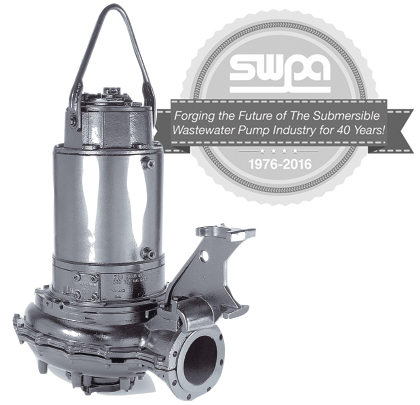Dry well submersible pumps can offer distinct advantages over conventional dry pit installations for both the installer and the user. For example, they can present a low initial cost since they involve only one pit and less auxiliary equipment than would be required than for dry well/wet well installations. In this month’s SWPA Insight, current SWPA Vice President Lisa Riles of Xylem–Flygt answers your questions about dry well submersibles pumps—highlighting their economic, installation, and maintenance benefits.
What advantages do dry well submersibles offer over conventional dry pit installations to both the installer and the user?
Dry well submersibles pumps provide a compact, single pump and motor unit that does not require a separate lubrication system. The unit does not require alignment, so it runs quieter and with less vibration. Since it is a submersible design, it is flood proof, which makes it a perfect solution if there is a power outage or disaster.
Municipalities are faced with many financial problems as well as an aging infrastructure and reduced service personnel. How can dry well submersibles help them meet their budgetary needs?
The dry well submersible pump design provides an economical retrofit solution to existing conventional dry pit installations, whether horizontal or vertical design. The compact design makes retrofits simple and the reduced maintenance time and costs are additional benefit to municipalities with limited resources. Eliminating conventional dry pit mechanical couplings, drive shafts, lubrication systems, etc. minimize the need for maintenance. Features such as inspection hatches and horizontal pull out service cart designs are available on submersible dry pit pumps which further simplify service.

Dry well submersible pumps are getting larger in horsepower and discharge sizes every year. What effect does this have on pump users around the country? How much of this is driven by coastal users, who are purchasing these pumps for storm drainage?
The flood proof design of submersible dry pit pumps makes them ideal for coastal climates where storm damage is imminent. Any system that can potentially experience flooding should use a submersible design to protect their investment from damage.
What are some of the installation advantages of dry well submersible pumps?
Dry well submersibles pumps provide advantages over a typical wet well installation, Access to the equipment for inspection and service is easier for personnel. They also don’t need to go into the wet well, which makes service cleaner and easier. ◆
For More Information:
The Submersible Wastewater Pump Association (SWPA) is a national trade association representing and serving the manufacturers of submersible pumps for municipal and industrial wastewater applications. Founded in 1976, the association’s primary focus is on industry guidelines, education and promotion. For more information, contact SWPA headquarters at 847.681.1868 or visit www.swpa.org.
____________________________________________
MODERN PUMPING TODAY, April 2016
Did you enjoy this article?
Subscribe to the FREE Digital Edition of Modern Pumping Today Magazine!
![]()


